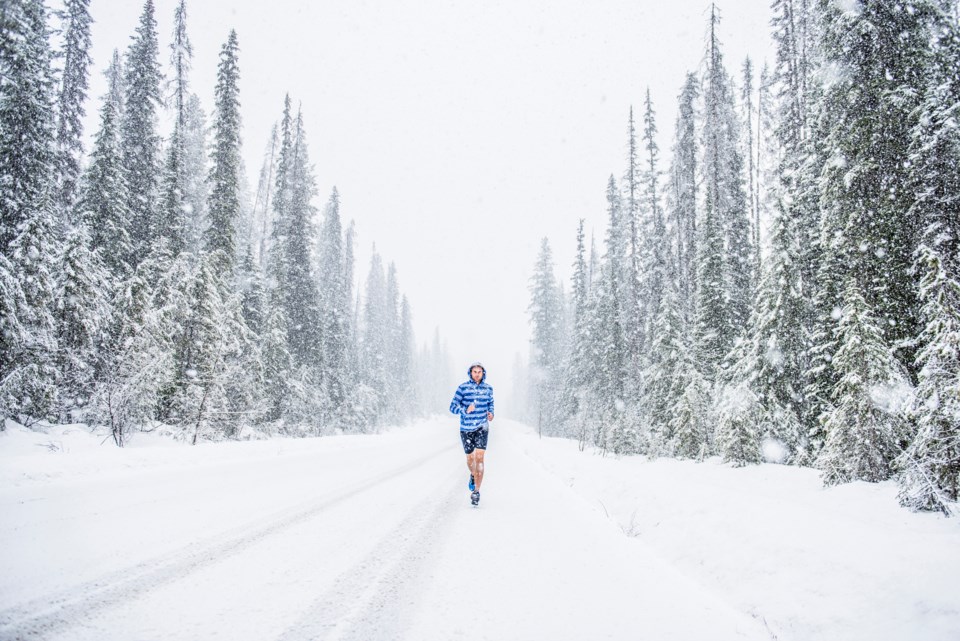Let’s face it, winter in Canada is a reality we can’t ignore. And for many of us, it means getting outside and into the cold for work, chores and exercise. But there are ways to improve your comfort and safety while being active outdoors in cold weather.
First off, “cold” is what physiologists (people who study human function and structure) call a “stressor,” which means your body recognizes cold as something it needs to accommodate to stay in homeostasis (when your body functions are steady).
We can immerse ourselves in different types of cold — including cold air and cold water — where the cold environment can be accentuated by wind and snow or rain. Here are some guidelines for exercising in cold air — there is different advice .
If you have underlying heart conditions or high blood pressure, talk to your physician about how long you should stay outdoors and what sorts of activities are recommended for you in winter.
Maintaining core temperature
Interestingly, in a nude or semi-nude state your body starts to recognize cold as a stressor at about 28.5 C. At this air temperature, your body’s coping mechanisms kick in to ensure your core temperature is maintained. This is why when you step out of a shower, or have few clothes on (like laying on a beach in summer) you will often shiver.
Adding insulative clothing to your body lowers the temperature you start to sense cold stress. In cold weather environments, our bodies produce a lot of heat when using energy to move our muscles for activities like shovelling snow or cross-country skiing. So if we wear proper insulative clothing and do enough muscular work, we can feel quite comfortable — what is called thermal comfort — in cold to very cold weather.
However, there are still ways to reduce risk and improve comfort while exercising outside in cold weather. Here are some things to think about as you make decisions about exercise outdoors in the winter.
Cover your skin
Reduce your exposed skin, everywhere you can. The indicate that frostbite, which is a “direct freezing injury … of skin surface” can occur at just -3 C. Tissues with less blood flow, such as hands, feet and head are more vulnerable, especially when the cold air is extreme (less than -15 C air temperature or -27 C wind chill).
Frostbite can be accelerated by contact with cold materials (metal, snow, ice) and by wet skin. Wear insulative clothing that has a high wicking ability to draw moisture off skin, and keep your head, feet and hands covered at all times!
Your face should also be covered for a few reasons. Covering your cheeks, forehead, nose and neck improves regulation of thermal comfort, especially in windy conditions, making activities like tobogganing or alpine skiing more comfortable. The skin on your face can takes a real beating — .
If you have some underlying chronic conditions, including high blood pressure or heart disease, you should cover your face. Exposing a bare face to cold — as little as -5 C — engages parts of the nervous system which can increase blood pressure. Simply wearing a toque and scarf .
Protect your lungs and breath
Our lungs are especially vulnerable to cold air environments, where exercise actually increases the stress on the lung in winter conditions. Your lungs, for good reason, want to warm and humidify the air we breathe to body temperature and 100 per cent humidity. They do a really good job of this at rest, but during exercise, it requires more effort to condition the air you breath in.
Add cold air on top of high breathing rates (as seen during exercise) and your lungs are really challenged to warm and humidify each breath. Cooling of the airway is associated with a nervous system response and drying of the airway is associated with an inflammatory response, both .
Cold weather activity at less than 0 C, at moderate exercise intensity (brisk walking pace), including the very common runny nose and feeling irritated in the nose (itchy, burning sensation). For more intense exercise (like a hard run or cross-country ski) the symptoms increase, and can include excess mucous, productive cough (getting that mucous out) and unproductive cough (irritating cough), chest tightness (trouble breathing), wheeze and sore throat; .
You can take several actions to reduce these symptoms. First, slowing down your exercise intensity gives your body a chance to condition the air in each breath. Second, covering your mouth with a buff, scarf or can help some capture moisture to humidify the next breath in. Third, reducing your total exposure time in cold air, because even 30 minutes of moderate exercise can increase your symptoms and airway constriction. And finally, drink enough water during prolonged bouts of cold weather because you can lose up 100 millilitres of water per hour due to heavy breathing exercise in cold air.
Being prepared
Being unprepared in cold weather increases your overall risk of hypothermia and other cold weather related injuries. In fact, more than half of deaths associated with natural weather events are due to cold weather — directly to accidental hypothermia (severe drop in core temperature leading to death) or when . Note that accidental hypothermia can also occur in moderate cold, .
It is also well documented that consumption of alcohol is a major risk factor in accidental hypothermia, . Other cold weather injuries include frostbite and frostnip, which can result in severe health consequences .
I hope this has helped you better understand some of the physiology behind how humans interact with cold air environments. More importantly I hope you can use some of these tips to enhance your enjoyment and safety in the winter, especially when the temperature dips well below 0 C.
![]()
Michael Kennedy receives funding from MITACS.




